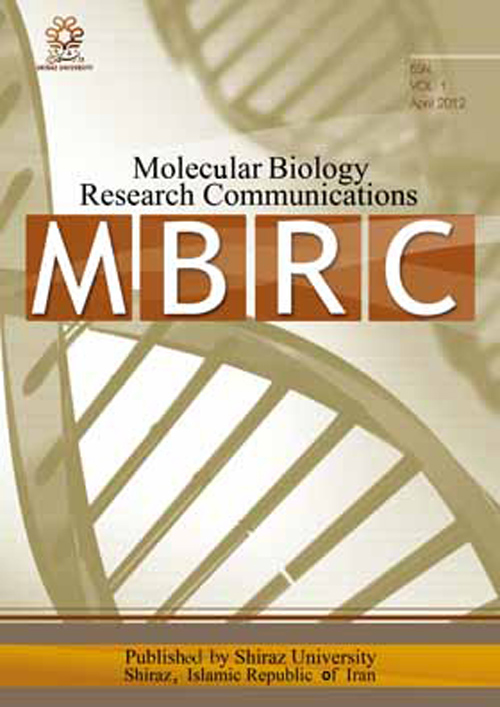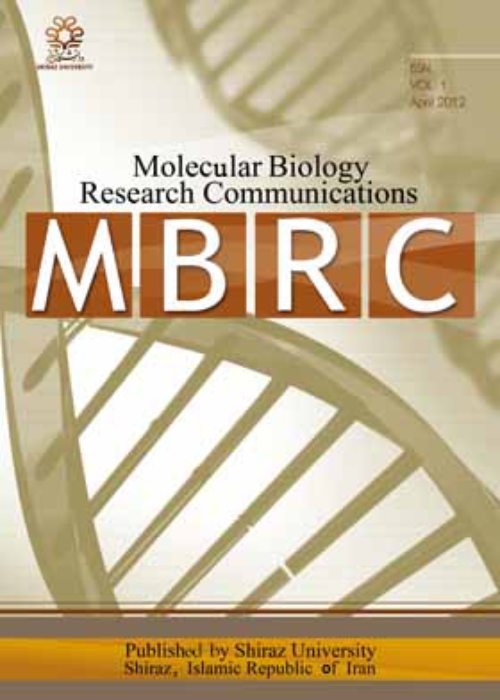فهرست مطالب

Molecular Biology Research Communications
Volume:7 Issue: 3, Sep 2018
- تاریخ انتشار: 1397/06/13
- تعداد عناوین: 6
-
-
Pages 97-106The DNA structure checkpoint protein Rad26ATRIP is also required for an interphase microtubule damage response. This checkpoint delays spindle pole body separation and entry into mitosis following treatment of cells with microtubule poisons. This checkpoint requires cytoplasmic Rad26ATRIP, which is compromised by the rad26:4A allele that inhibits cytoplasmic accumulation of Rad26ATRIP following microtubule damage. The rad26::4a allele also disrupts minichromosome stability and cellular morphology, suggesting that the interphase microtubule damage checkpoint pathway operates in an effort to maintain chromosome stability and proper cell shape. To identify other proteins of the Rad26-dependent interphase microtubule damage response, we used ultra violet (UV) radiation to identify extragenic interaction suppressors of the rad26::4A growth defect on microtubule poisons. One suppressor mutation, which we named mut2a, permitted growth of rad26:4A cells on MBC media and conferred sensitivity to a microtubulin poison upon genetic outcross. In an attempt to clone this interaction suppressor using a genomic library complementation strategy, we instead isolated pap1+as an extracopy suppressor of the mut2a growth defect. We discuss the mechanism by which pap1+ overexpression may allow growth of mut2a cells in conditions that destabilize microtubules.Keywords: DNA structure checkpoint, interphase microtubule damage response, extragenic suppressor, pap1, rad26ATRIP
-
Pages 107-118Current re-emergence of Nipah virus (NiV) in India caused 11 deaths so far and many patients were kept in quarantine. A thorough study of previous outbreaks occurred in Malaysia, Bangladesh and India represents cases with high rate of fatality due to acute encephalitis. Our work involves genome analysis of NiV for prediction of miRNAs and their targeted genes in human in order to understand encephalitis origin. Ab-intio program-VMir was used for initial screening of genome, obtained nine pre-miRNAs was analyzed by ViralMir to check for any pseudo pre-miRNAs. Eighteen functional mature miRNAs were extracted from pre-miRNAs by using Mature-Bayes tool, which targets 669 genes in human genome as retrieved by miRDB. Gene ontology terms by PANTHER provide important pathways in which target genes were involved like Axon guidance, T cell activation, and nicotinic acetylcholine receptor signaling. Significant outcome was obtained after NCBI Gene and OMIM database mining and literature search for predicted target genes. TLR3, TJP1, NOTCH2, FHL1, and GRIA3 target genes obtained showed their involvement in host defense, blood brain barrier, neurogenesis, mental retardation and encephalitis. To conclude, we predicted significant genes in human that can be inhibited by miRNAs of NiV and results in etiology of encephalitis.Keywords: Nipah, miRNA, Encephalitis, Target genes
-
Pages 119-124Several studies examined the relationship between STAT3 rs1053004 polymorphism and the risk of some human cancers, but the findings remains inconclusive. To evaluate the impact of STAT3 rs1053004 on cancer risk, we conducted a meta-analysis of all available studies including 4,605 cancer cases and 5,248 controls. Eligible studies were identified by searching PubMed, Web of Science, Scopus, and Google scholar databases. Pooled odds ratios (ORs) with 95% confidence intervals (CIs) were calculated in codominant, dominant, recessive, overdominant, and allele models to quantitatively estimate the association. The overall findings showed no significant association between STAT3 rs1053004 polymorphism and cancer risk in codominant, dominant, recessive, overdominant, and allele inheritance model tested. In summary, the findings of this meta-analysis indicates no significant association between STAT3 rs1053004 polymorphism and cancer development. Larger and well-designed studies are necessary to estimate this association in detail.Keywords: STAT3, Cancer, Meta-analysis, Susceptibility
-
Pages 125-132This study describes the genetic relationships among 34 varieties of Lallemantia iberica using inter-retrotransposon amplified polymorphism (IRAP) and retrotransposon-microsatellite amplified polymorphism (REMAP). Samples were collected from Agriculture Research Center of Urmia city (northwest Iran). Ten IRAP and REMAP primers generated 76 scorable electrophoretic bands with 78.94% polymorphism. The pair-wise Jacquard genetic similarity varied from 0.48 to 0.94 for IRAP and REMAP data combined. Average PIC values for IRAP and REMAP markers were 0.38. The retro-elements marker system produced 76 alleles in range of 100- 3000 bp. The cophenetic correlation coefficient between Jaccard’s similarity matrix and the plotted dendrogram was 0.66. A dendrogram constructed based on COMPLETE LINKAGE. Cluster analysis of IRAP and REMAP data using the NTSYSpc 2.02 resulted in five clusters. The present study represents high genetic distance at genotype level suggesting that IRAP and REMAP markers are useful for Lallemantia ibericagenetic diversity analysis.Keywords: Genetic diversity, IRAP, REMAP, Lallemantia iberica, Dendrogram
-
Pages 133-141Recently non-thermal plasma (NTP) is applied for many therapeutic applications. By NTP irradiating to the tissues or cell-lines, the water molecules (H2O) would be also activated leading to generate hydrogen peroxide (H2O2). By irradiating plasma to bio-solution, its main output including vacuum UV to UV causes the photolysis of H2O leading to generate hydroxyl (OH) molecules in couple forms with ability to convert to H2O2. Additionally, other plasma’s output the oxygen atoms could also penetrate under the liquid’s surface and react with H2O to generate H2O2. In NTP applications for killing unwanted-cells of microorganisms (e.g. sterilization) or cancerous tissues, the H2O2 molecule is the main reactive species for cell death via inducing DNA damage in mammalian cells. In this paper we proposed a mathematical model for NTP application describing the formation of hydroxyls in the bio solution and other subsequent reactions leading to DNA damage in vitro. The instant concentrations of the OH and H2O2, the main species for DNA oxidation were obtained and investigated in this simulation. In order to validate the model, the cellular response to NTP stimulation was compared with some experimental findings from viewpoint of DNA damage to show the significant consistency.Keywords: Modeling, DNA damage, hydroxyl, peroxide, non-thermal plasma
-
Pages 143-152Genetic diversity estimation of plant materials is one of the important pre-breeding activities in breeding field crops. Twenty-one microsatellite markers used to assess genetic diversity and relationship of 68 sunflower genotypes (Helianthus annuus L.). All of 21 pairs of SSR (Simple Sequence Repeats) markers produced a total number of 49 polymorphic bands. DNA fragments ranged from 92 to 850 bp. The highest and lowest polymorphic information content (PIC) values were determined as 0.58 and 0.10 for marker Ha806-ar and Ha494-ar. The number of alleles per locus was calculated as 2-6 with the average of 2.86. In this study, CMS (Cytoplasmic Male Sterility) lines showed the highest and Iranian hybrids showed the least polymorphism, respectively. Principal coordinates analysis revealed that Iranian hybrids were well-separated compare to the other groups. The analysis of molecular variance (AMOVA) indicated higher genetic variation within groups (90%) rather than among groups (10%). This study revealed that the SSR markers such as Ha806-ar could be a useful tool for distinguishing sunflowers genotypes. According to the study, there is a significant genetic distance among individuals. Parental lines (R26 and CMS502 lines with lowest similarity coefficient) may be useful for future sunflower crossing and hybrid breeding programs. Generally, high similarity coefficient estimation among investigated sunflower groups revealed that there was a narrow genetic base in investigated materials suggesting broadening its genetic base by introduction of new genes into existing breeding materials.Keywords: cluster analysis, hybrid, polymorphism, principal coordinates analysis, SSR


